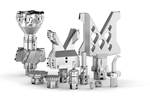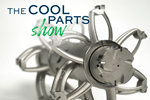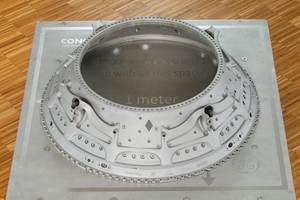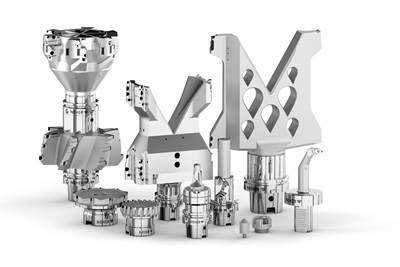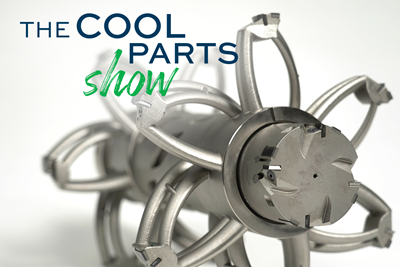DMG MORI is a maker of CNC machine tools for precision metal cutting, as well as systems for metal additive manufacturing — and one has been applied in service of the other. On a CNC machining center capable of grinding, the adapter directing cutting fluid to the grinding wheel was formerly made through machining and assembly. Internal fluid passages were drilled, then sealed at the surface of the part. Reengineering the part for additive manufacturing and producing it on one of the company’s laser powder bed fusion systems has resulted in consolidating 71 pieces into five, reducing sealing points from 46 to four, and cutting the weight of this part nearly in half. This part was recently chosen by viewers as the winner of our contest, The Cool Parts Showcase, in the category of Best Production Part. This episode discusses the thinking that went into the part’s production process, including developing a 3D printed accessory to speed depowdering. | This episode of The Cool Parts Show brought to you by Carpenter Additive
The Cool Parts Show is a video series from Additive Manufacturing Media that explores the what, how and why of unusual 3D printed parts. Watch more here.
Have a cool part to share? Email us.
Related Resources
- DMG MORI
- Winner of The Cool Parts Showcase for Best Bespoke Solution
- Winner of The Cool Parts Showcase for Best Proof of Concept
- More AM for machining – 3D printed cutting tools
Transcript
Peter Zelinski
3D printing and machining come together. This is a 3D printed part for a CNC machine tool.
Stephanie Hendrixson
In this episode, the winner of The Cool Parts Showcase for Best Production Part.
Peter Zelinski
I'm Pete.
Stephanie Hendrixson
I'm Stephanie.
Peter Zelinski
Welcome to The Cool Parts Show.
Stephanie Hendrixson
This is our show all about cool, interesting 3D printed parts. And we have here today one of the winning parts in our Cool Parts Showcase from 2021.
Peter Zelinski
Yeah. So Stephanie, a thing we love even more than brackets, CNC Machine Tools.
Stephanie Hendrixson
I think we love 3D printing more than that, but okay, go on.
Peter Zelinski
We love 3D printing. This is a 3D printed component for a CNC machine tool.
Stephanie Hendrixson
This part was the winner in our Best Production Part category. We were looking for something that is currently being made or sold, and that's what this is. This adapter is produced by DMG MORI. Major machine tool builder. They now also produce 3D printers and we'll talk about that later. But this particular component was produced for the machining side of their business.
Peter Zelinski
That's right. This is the AKZ FDS Adapter, a component of a machine tool, DMG MORI machine tool, big name in machine tools. And this goes on a CNC, computer numerical control machining center, a sort of machine that does milling, drilling, and in the case of this particular machine grinding as well. So this adapter helps deliver coolant, cutting fluid, to the cutting edge of a machine that has all those different kinds of tools in play, a milling tool or potentially a grinding wheel. And this adapter directs the cutting fluid to just the right place for all that different type of tooling.
Stephanie Hendrixson
Right. So this is an example of additive manufacturing helping subtractive manufacturing, helping machining, but it's also an instance of additive manufacturing as a replacement for machining, because that's how this component used to be made. Right?
Peter Zelinski
Right. So the essence of this part is fluid flowing through it, fluid flowing within it. And it was made conventionally prior to additive. But often in cases like that, where it's where it's an internal fluid flow component, it's made through assembly like those internal passages are built in the components built up around it. That wasn't how this was made previously. It was made through machining, and those internal fluid passages were achieved through drilling, straight drill, straight hole from the outside of the part, holes that intersect to make those internal passages. And then the outside of the hole was plugged up. It was sealed so that just the internal passages are left inside. So this part, there is some assembly reduction as a result of additive manufacturing. There is lightweighting, but there's also the elimination of almost all of those external sealing points because now those fluid passages are just printed into this solid part.
Stephanie Hendrixson
So I want to bring in one of our experts now. This is Hannes Ebbers. He is a project engineer for DMG MORI's Additive Intelligence department. So one of the things that this department does is look at different parts, customer parts, internal DMG MORI parts, and try to identify good use cases for additive manufacturing. He can talk more about how this part used to be made before they identified it as an opportunity for additive manufacturing.
Hannes Ebbers
Before it was a traditional milling part. So we haven't invented the ring completely new. So we had a block and created more chips than everything else. So most of the material, the metal from the block is waste. And on the other hand, we need these media channels inside of this part. So we have to drill deep small holes from one side to reach the other. And we have to drill from several angles. And we need to block most of the exits or starting points of the drilling holes. This is a little pain because we have more sealing points or connections that we have to clock than everything else. It's like cheese from Switzerland. More holes and more cavities inside of a metal part than everything else.
Stephanie Hendrixson
So I think that's a pretty good visual of what's going on inside of this part, the Swiss cheese analogy. And when you think of it in terms of subtractive manufacturing, previously, they started with a solid block of material. They were removing material to make those holes and then having to plug up the ends later. And now with additive, they can think more about building walls around the channels that they need and using less material, just putting it where it's absolutely necessary.
Peter Zelinski
So that's right. They were they were removing material. They were putting it back in the form of sealing these holes. Let's talk about DMG MORI, their equipment is most widely associated with material removal, precision metal cutting. But in more recent years, this company has also begun offering metal additive machines. So let's talk about how was this part made?
Stephanie Hendrixson
I think that's important, and that's a really cool part of this story because this component for DMG MORI machining technology was made on DMG MORI 3D printing technology. So the specific printer that they use for these is the Lasertec 30 Dual SLM. So it's a selective laser melting or laser powder bed fusion system and it has dual in the name because there are two lasers, two lasers doing the melting of the metal powder to build these up.
Hannes Ebbers
So we have a system with two lasers and we produce it and stainless steel 316L This on a dual laser system takes approximately 57 hours, still some hours, but this ring is not really small. After that we start with de-powdering inside of the machine. We open the doors, get out the parts, and then the de-powdering and a de-powdering machine next to our printers starts. Of course, this is really important because of all the cavities inside and the channels. It's really important to get rid of all the powder because the next step is the heat treatment. This is quite a big part, was a diameter of 300 millimeters. So it has some residual stresses and we want to get rid of them. And so for this it is very important that there is no powder left in the channels. And after that we go to our milling machine. So we use the print plate, the base plate for clamping. On the milling machine we separate our AKZ ring from the solid support we have inside for de-powdering and everything. So we separate that one. Then we get out the plate and the rings, go to the band saw, cut it off, separate the ring from plate, and then we go back to the milling machine and start to work on the part again, finishing the part. Then quality control and we have our final part.
Peter Zelinski
Hannes mentioned de-powdering and that's actually a really interesting part of this. To make the de-powdering step more efficient, they actually 3D printed another component that aids specifically in that operation. So here's another voice, another person associated with this work, Nils Niemeyer. He is the general manager of the additive manufacturing business for DMG MORI in North America.
Nils Niemeyer
Once we're finished printing the parts, we are de-powdering the build chamber. And so the designers came up with a very clever way of doing it. In fact, there are channels in the center of the sealing ring and we can apply the vacuum off the machine, the vacuum hose to those holes and extract the powder in a very efficient way. Now, this is sacrificial material and it is not functional for the actual part in the end. So after we de-powder the part in an efficient manner, we put it on a machining center and cut that ring out in the center as well we finish all the functional surfaces. So we de-powder the part first and then we finish machine the part in the final step.
Stephanie Hendrixson
There's something I really like and appreciate about this particular part. Like we were looking for a good production use case of additive manufacturing, and that's exactly how DMG MORI approached the design and manufacture of this component. They thought through everything, everything from how do we orient the part in the printer, like how should it be printed to how are we going to remove all of that powder from these channels? And let's add this extra feature to make that easier. To how are we going to clamp and fixture this in a machine tool for the finished machining? They thought through the whole thing.
Peter Zelinski
Right. They saw this opportunity that this part could be better with 3D printing. But there was also this recognition that design and production are different and they thought about them separately. Hannes has more to say about that.
Hannes Ebbers
You always should focus on the whole process. That is always important. What I see when I'm working with customers, we have a lot of customers from milling, or sometimes we have customers they are just in printing but the process is so important. In the first step, in the development phase you should have or make some ideas about how to clamp the part, how to get out the powder. You have seen this solid support we have designed and not created automatically with a work preparation software tool just because we have the process in mind.
Stephanie Hendrixson
So there was a lot of work that went into this part on the back end to develop it and to get it ready for production. But let's talk about results. How is this 3D printed adapter better than what came before it?
Nils Niemeyer
So the performance of the part is significantly increased by functionally integrating several components of an assembly into one print. And that way we're reducing the sealing points, and that way we can much better bring the coolant towards the grinding wheel.
Hannes Ebbers
So we had 15.6 kilograms from the traditional design, from the milled design. Now we have eight kilograms, so we have a light weight ring now. We had a lot of sealing points from all around the part. And so we reduced the sealing points from 46 to just four. Now we have four sealing points. And we reduced the amount of parts we need for the assembly from 71 to just five. But we have a little bit more. We have the channels itself. The initial design was just drilled holes and so it wasn't really optimized for our flow. We had losses of pressure. And now we are optimized, flow optimized design we have now. Another point is we have reduced commissioning warehousing of all the different parts. The part is more simple. Now we have, of course, a printed design, but we don't have the all the complex assembling process to have later our channels. And last point is another advantage. The initial design, the milled design, we needed special tools, a longer drill tool. Special tools are always expensive. And now we print the part and the final machining on our milling machines, we can do that with standard tools. Standard and so not so expensive tools.
Stephanie Hendrixson
All right. I think we got this. You start.
Peter Zelinski
Sure. This is the AKZ Adapter for a DMG MORI machining center. A machining center that, along with milling and drilling, is also capable of grinding. And that's what this particular adapter is all about. It's all about getting the cutting fluid, the coolant to those different kinds of tools, end mills and grinding wheels that might be used on this machine. This was made through additive manufacturing, but it wasn't always made that way. There was an earlier version of this adapter made through more conventional processes, and in the case of that earlier part, to get the fluid channels that flow through this adapter that was done through drilling. Holes were drilled from the inside. They intersected to make these channels. And then all those entry points for all those holes were sealed up. This is a simpler design. It's a lighter design. And by being one piece and containing all of those channels, it eliminates almost all of those sealing points that had to be done just right or else they were risks for leakage.
Stephanie Hendrixson
The 3D printed version of this adapter is produced through laser powder bed fusion on one of DMG MORI's own 3D printers. As you say, it simplifies the manufacturing process a great deal because you're not drilling those holes, you're not removing material to then put it back later. They're just building what they need to produce this part, with the exception that they do add additional features to make the post-processing easier. So there is a special part that we don't have here in the finished version that makes the vacuuming of the loose powder easier to do. After it gets vacuum it goes through heat treat, it goes through finished machining, and you end up with this final part. This component is lightweighted. It weighs about eight kilograms versus the more than 15 kilograms that the original did. It's more reliable. It has fewer sealing points. And this is just a great illustration of additive manufacturing helping subtractive manufacturing.
Peter Zelinski
It won our contest last year based on audience votes, our Cool Parts Showcase in the category of best production part, and it is a great production part, a great example of additive for production. They thought all the way through the production process to the extent of also finding a more efficient way to do de-powdering.
Stephanie Hendrixson
So congratulations again to DMG MORI on your win. If you want to see our other episodes with showcase winners, you can find all of those on the channel or at TheCoolPartsShow.com. In the bespoke solution category, we had a wheelchair custom made for a dog and in the best proof of concept category, a helicopter heat exchanger. They're both very cool and you should check them out.
Peter Zelinski
If you have a cool part to share, maybe a component of your machine that you re-engineered for additive manufacturing, we would like to know about it. We might do an episode of the show about it. Email us. CoolParts@AdditiveManufacturing.media.
Stephanie Hendrixson
If you enjoyed this episode, leave us a like. Leave us a comment. If you have questions, let us know. And make sure to subscribe so you get notified about all of our new episodes. Thanks for watching.
Related Content
This Drone Bird with 3D Printed Parts Mimics a Peregrine Falcon: The Cool Parts Show #66
The Drone Bird Company has developed aircraft that mimic birds of prey to scare off problem birds. The drones feature 3D printed fuselages made by Parts on Demand from ALM materials.
Read MoreBike Manufacturer Uses Additive Manufacturing to Create Lighter, More Complex, Customized Parts
Titanium bike frame manufacturer Hanglun Technology mixes precision casting with 3D printing to create bikes that offer increased speed and reduced turbulence during long-distance rides, offering a smoother, faster and more efficient cycling experience.
Read More8 Cool Parts From Formnext 2023: The Cool Parts Show #65
New additive manufacturing technologies on display at Formnext were in many cases producing notable end-use components. Here are some of the coolest parts we found at this year’s show.
Read MoreGE Additive Helps Build Large Metal 3D Printed Aerospace Part
The research is part of an initiative to develop more fuel-efficient air transport technologies as well as a strong, globally competitive aeronautical industry supply chain in Europe.
Read MoreRead Next
3D Printing Lightweights Large Cutting Tools Used in Machining
Larger machined parts require larger, heavier cutting tools. 3D printing enables Star SU Neher to produce lightweight large tool bodies and add features that improve tool life and performance.
Read More3D Printed Tool for Machining Electric Vehicle Motors: The Cool Parts Show #39
Additive manufacturing achieves a large-diameter cutting tool light enough for fast, precise machining of the motor housing’s stator bore.
Read More3D Printed Polymer EOAT Increases Safety of Cobots
Contract manufacturer Anubis 3D applies polymer 3D printing processes to manufacture cobot tooling that is lightweight, smooth and safer for human interaction.
Read More


